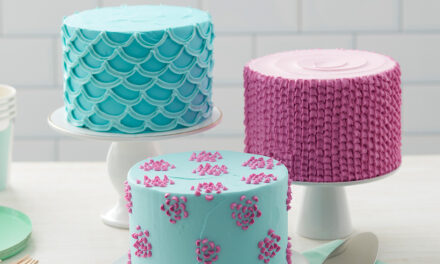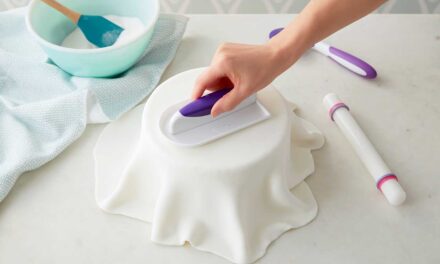While petal piping tips are great for making flowers, you can also use them to pipe leaves, ruffles, swags, bows and more. Read on for more creative ways on how to use petal piping tips in your cake decorating projects.
Petal tips are a must for anyone who loves piping buttercream flowers; however, they can also be used to create a handful of other designs.
Available in a variety of sizes, petal tips give your decorations dimension and texture. They’re available in a variety of sizes and which one you use will depend on the treat size and the technique.
As is the case with most tips, it’s a good idea to have multiples of the petal tips you use most often, especially when creating floral designs. This makes it easier to switch tips and prep several bags at once for quicker and easier decorating.
How to Pipe Buttercream Flowers
Whether you want to create small or large blossoms, petal tips are essential for creating life-like flowers with great dimension. Petal tip flowers are often piped on a flower nail or a lily nail, then transferred onto the treat. However, you can pipe some flowers directly onto your cake or cupcake.

Stand-Up Petals
A ribbon rose is a perfect flower for beginners, and it can be piped with any sized petal tip. Tip 101s is just the right size for the cascading ribbon roses on these Mini Wedding Cake Cookies.
Tip 102, 103 or 104 will produce larger ribbon roses, like the ones on these Blooming Ribbon Rose Cupcakes.
The ranunculus is another great flower for beginner decorators. The petals are piped with tip 61 and you’ll want to be sure to have two of them, one for each icing color, to create this two-toned, realistic look.
For a stunning spring treat, try this Tulip Cake. Tip 123 is used to create the stand-up petals on these buttercream tulips. Try striping your bag with different buttercream frosting colors for a more realistic look!
Sweet peas piped with tip 102 help to create the soft and delicate look on this Breath of Spring Floral Cake.
Tip 102 can even transform sweet peas into a sweet stitch, perfect for cookies or cupcakes. Simply pipe rows of sweet pea petals in a “V” shape, working from top to bottom, to create the knitted effect on these Scalloped Heart Cookies.
Flat Petals
Most flat petal flowers start out the same. By simply changing the tip size, flower center, number of petals or frosting color, you can create a different flower shape.
For example, the petals of a dogwood are piped much like those of a primrose. They both use tip 104 and both have heart-shaped petals. The only difference is the number of petals and the center of the flower.
For super-realistic flowers, try spatula striping your decorating bag. That’s the technique used to create the dogwood flowers on this Dogwood Blossom Cake.
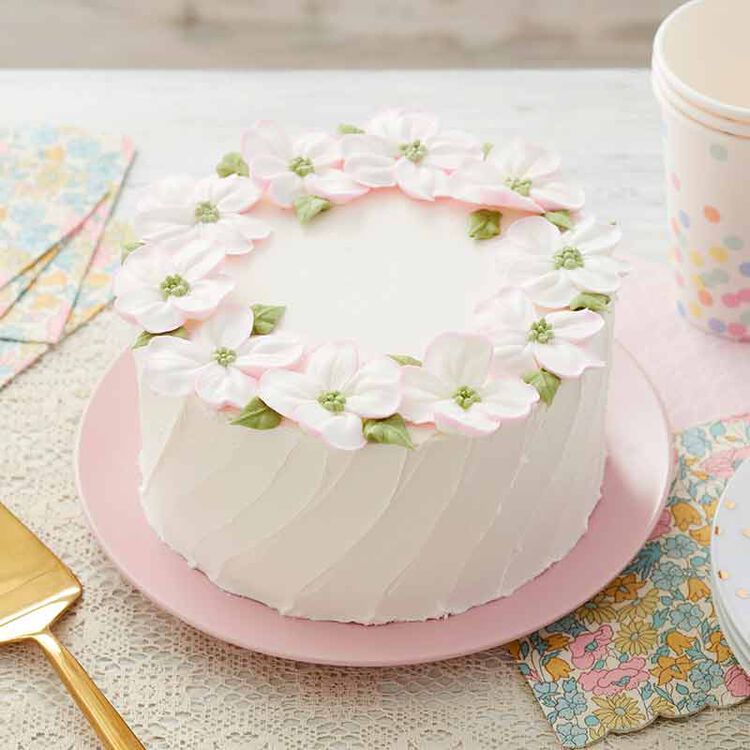
Apple blossoms are piped with tip 101 and have a center of 5 small dots. About the size of a penny, apple blossoms are an ideal flower for smaller treats and can also be used as a filler in a floral design on larger cakes.
Need a flower slightly smaller? Use tip 101s to create these Forget-Me-Not Flowers, which will reduce your flower size down to smaller than a dime.
The violet’s asymmetrical shape and double-dot center make it unique and easily identifiable amongst the other smaller flowers. The tip used to create the violet, tip 59 (or 59L for left-handed decorators), has a uniqueness of its own as well, with its slightly curved opening. The violet is equally as beautiful as a filler flower on a cake or a stand-alone flower on a petit four.
This Quiet Violets Cake has a border of blooming violets, making this cake great for wedding showers, bridal showers, birthdays and more.
Tiny lilac blossoms can also be created with tip 59. Use varying shades of the same color and attach them in clusters over an elongated shell-shaped base for a gorgeous life-like flower.
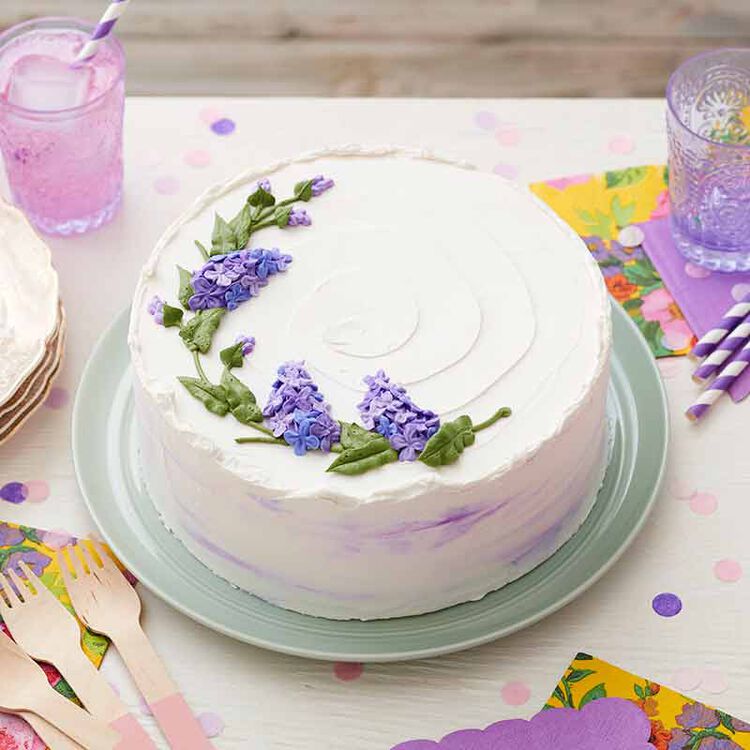
This Lovely Lilac Flower Cake is almost too pretty to eat! Featuring three clusters of lilac flowers, this cake makes a wonderful treat for any spring or summer celebration.
No matter which flower you choose for your project, there’s a petal tip to create just the right size to fit the project perfectly. A wild rose can go from pint size to supersize by simply switching tips from 103 to 127.
Tip 102 is just the right size for this Climbing Wild Roses Cake. With flowers blooming in the center and around this cake, you will have plenty of opportunities to perfect this simple piping technique!
Tip 127, however, will enable you to maximize your flower power, like the single flower topping this Wild Rose Cake.
How to Pipe Buttercream Leaves
Though leaf tips have their own tip family, you can certainly use petal tips to pipe certain leaf varieties.
Made with tip 104, the dark blue leaves in this Whimsical Oblong Floral Cake have a slight resemblance to the daisy petal.
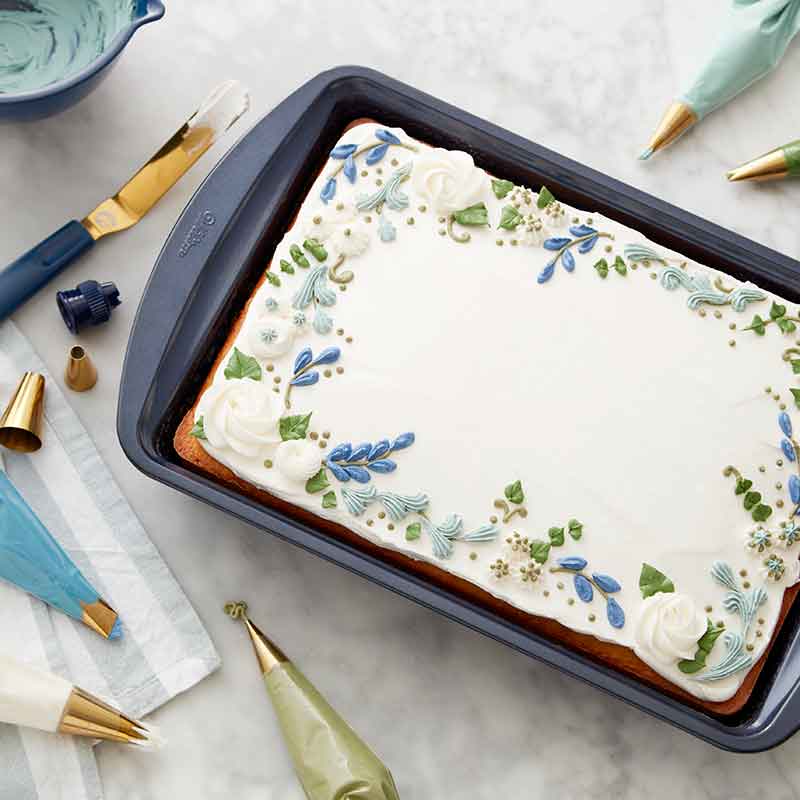
How to Pipe Ruffles and Ribbons
Petal tips are also used to add interest to the sides of cakes, whether it’s adding some bounce to a border or layers of texture.
Create a crepe-look by piping tight vertical ruffles with tip 126, which pairs perfectly with the delicate paper-like petals on this Peony Crepe Wedding Cake. Keeping steady pressure on your decorating bag and changing up the wave design to avoid a uniform look are key to achieving this stunning effect.

Achieve a whole new look by ramping up your ruffle size with tip 127D and piping the ruffles diagonally. That’s the secret to getting the awesome texture of this Pretty in Pink Adult Smash Cake!
Ruffles also make a beautiful top or bottom border for cakes. To obtain the graceful motion of a ruffle, be sure to keep the wide end of your tip touching the cake as you move your wrist up and down. Use a large petal tip like 127 for larger cakes and tip 103 for smaller cakes and cupcakes.
Ruffles can also be used to add feathers or accents to your treats. These Ruffled Flamingo Cookies use petal tip 101 to create some fun and fluffy feathers!
Add dimension to your treats by layering your ruffles, like on these All Ruffled Up Cupcakes.
Whether you want the look of loose flowing ribbons, layered bands of straight ribbon, or a single ribbon tied in a bow, a petal tip can help you get the job done. The rippling texture of this Golden Shimmer Rosette Cake are piped with tip 127, starting at the top edge and overlapping the rows as you work toward the bottom.
Downsize to tip 103 and pipe narrower waves to space the ribbons closer together for this Pretty Poppy Cake. Be sure to keep that tip 103 handy to pipe the beautiful poppies too!
Whether you need to finish off a floral bouquet with a big ribbon bow or your gingerbread girl needs a touch of adorableness in her hair, a petal tip can help you do that. Tip 101 is perfect for petite bows or go big with your bow using tip 124.
No matter which size you need, the technique is the same; use a figure-8 motion to create the loops, then add streamers.
How to Pipe Swags and Garland
Petals tips can also be used to add swags and garlands to the sides of a cake. Layer on swags using tip 103 or 104 as a bottom border or pipe over a ruffle garland to add a lighter-than-air elegance. This Scalloped Giant Rose Cake is topped with a tip 103 border to help add texture to the top tier of the cake.
Whether you are new to cake decorating or an expert, tap into your creativity and you’ll find endless possibilities of what you can do with petal tips! We’d love to see what you’ve made with them so be sure to post your pictures on Instragram and tag us @wiltoncakes.


